| | Varieties | Spring triticale varieties | Winter triticale varieties | Seeding triticale | Fertilizer requirements of triticale | Grain harvest and storage | Triticale grain grade standards | Plant Breeders' Rights
Varieties
A diversity of spring triticale varieties with high grain and forage yield potential are available to producers. The number of adapted winter varieties is fewer than for the spring types. These varieties also allow a greater diversity of crop rotational options for improved protection from disease and insect damage. As well, the potential biomass production capability for these varieties exceeds that of most other cereal crop options under Western Canadian conditions.
Registered triticale varieties have an excellent disease resistance profile. Although they are more resistant than some other cereals, the late maturity of the spring varieties limits suitability for grain production in some areas.
Winter triticale varieties are as winter hardy as the best winter wheat varieties but less than fall rye.
Registered triticale varieties are well suited for grain and silage operations. These operations include:
- Forage mono-cropping.
- Inter-cropping and double cropping.
- Other special forage applications.
All spring and winter varieties are rated as good to very good for resistance to stem rust (except Pronghorn, which is rated as poor in Manitoba), leaf rust, and bunt. They are all rated as resistant to loose smut.
Triticale in general has superior drought resistance compared to barley, wheat and oat.
Spring Triticale Varieties
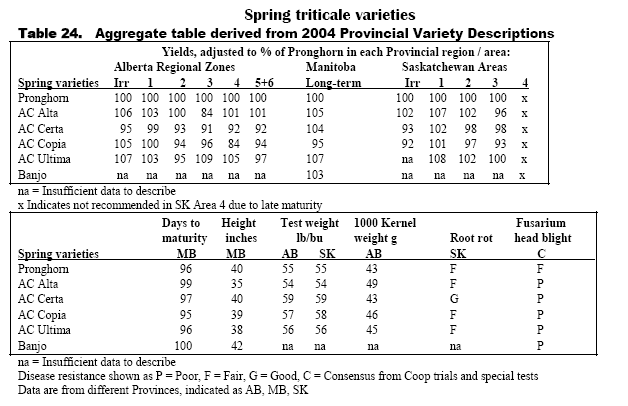
Other agronomic traits:
- All spring and winter varieties are rated as good for shattering and lodging resistance.
- In most regions, spring triticale varieties are typically as late as or later maturing than AC Crystal CPS wheat.
- Compared to other cereal species, triticale varieties have only a fair tolerance to pre-harvest sprouting.
- AC Ultima is a variety bred for improved sprouting resistance. It has a high Hagberg Falling Number, which is associated with a lower proneness to sprout.
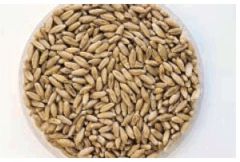
Photo - Pronghorn spring triticale
Winter Triticale Varieties
Winter triticale is a high yielding, early maturing alternative to spring triticale for short-season areas of the prairies.
Pika and Bobcat are the only two winter varieties currently registered for Western Canada, and typically mature about three weeks earlier than spring varieties. Their winter hardiness is rated as equal to that of the best winter wheat varieties, but not as high as fall rye.
Bobcat is awnletted, with shorter and stronger straw than Pika. It is also easier to thresh than Pika. Bobcat is best suited to areas of higher snowfall, higher summer rainfall, or irrigation.
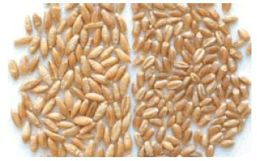
Photo - Pika winter triticale (left) and Neepawa wheat (right)
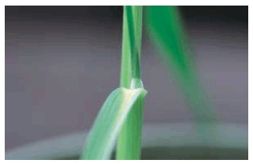
Photo - Pika winter triticale. Ligule, with larger auricles than wheat but smaller than barley
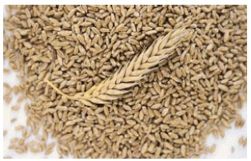
Photo - Bobcat winter triticale (reduced awn)
Winter triticale is best adapted for seed production in the Brown soil zone of Southern Alberta, and in high snowfall areas such as the Black soil zones of the prairies. In areas of good adaptation, winter triticale yields may exceed those of winter wheat by as much as 10 to 20 percent (Table 25).
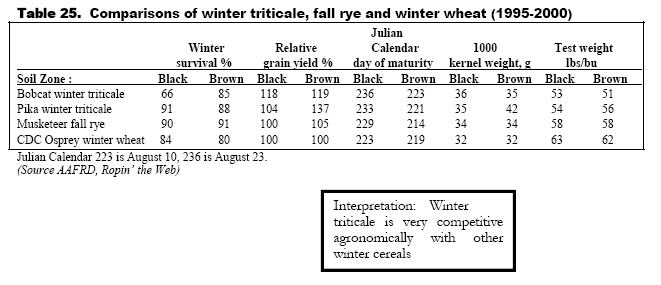
Top 10 Reasons to Grow Winter Triticale
The top ten reasons to grow winter triticale in Western Canada are the same as for winter wheat (taken from the website http://www.usask.ca/agriculture/plantsci/winter_cereals)
- Good fit with conservation farming systems.
- Uses water more efficiently than do spring-seeded crops.
- Avoids wheat midge damage because of early heading. This reduces insecticide use.
- Good weed competitor, so wild oat herbicide may not be required
- Not spraying for wild oat control reduces risk for developing herbicide resistance.
- Reduced risk of fusarium head blight due to early development and maturity.
- Avoids seeding problems in late, wet springs, and offers earlier, less risky harvest dates.
- Reduced tillage and pesticide use means lower energy requirements.
- Less disturbance of wildlife, especially waterfowl and upland game birds.
- High yields and lower input costs offer a high probability of increased returns per acre.
Seeding Triticale
Most cultural practices needed for growing triticale can be taken directly from wheat. These include:
- Managing for seedbed preparation
- Seeding rate
- Seeding depth
- Seeding date
- Seeding methods
Triticale seeding rates
- Plant more weight of triticale seed per unit area than when planting wheat. This is because triticale has larger seeds than does wheat.
- Adjust seeding rates to achieve targeted plant densities for specific triticale uses and conditions.
- Keep in mind that optimum seeding rates vary depending on what the triticale will be used for.
If seeded on its own (mono-crop) for forage, the minimum seeding rate for triticale should be at least the same as the seeding rate used for grain production, or somewhat higher (up to 25 percent), to ensure adequate stand establishment.
When planting mixtures with triticale (inter-cropping), the seeding rate for the mixture is adjusted upwards from the normal rate. However, the seeding rate for each component of the mixture is lowered. Research at the Field Crop Development Centre in Lacombe indicated that 75 percent of the normal recommended rate for each of the components is optimum. For example, if the normal seeding rates for triticale and barley is 2 bu/ac, for a triticale and silage barley mixture the rates should be adjusted to 1.5 bu/ac of triticale and 1.5 bu/ac of silage barley, for a total seeding rate of 3.0 bu/ac. The same recommendation applies to spring/winter cereal mixtures seeded in spring for grazing.
Some quick facts about seeding triticale:
- Choose and manage seeding rates to achieve target plant stand densities in the field.
- Triticale has the largest seed size of all common small-grained cereal crops. Ensure that your seed rate compensates for this.
- Optimum seeding rates depend on the use that is planned for the crop and on local conditions. Check provincial recommendations for general guidelines.
- Rates are usually adjusted upwards when seeding forage mixtures or inter-cropped triticale.
- For mono-crop triticale forage production, recommended seeding rates are usually 25% higher than seeding rates for grain production.
- In two-component forage-crop blends using triticale, one guideline suggests each component consist of 75 percent of the normal seeding rate for the individual components alone.
For best management practices, triticale should be seeded to achieve a desired target plant stand frequency in the field. For this, the 1000 kernel weight (g) of the seed source must be known. Note that triticale has a much larger 1000 kernel weight than do other cereals.

Plant populations recommended in Table 27 and Table 28 are based on research results obtained over several years.

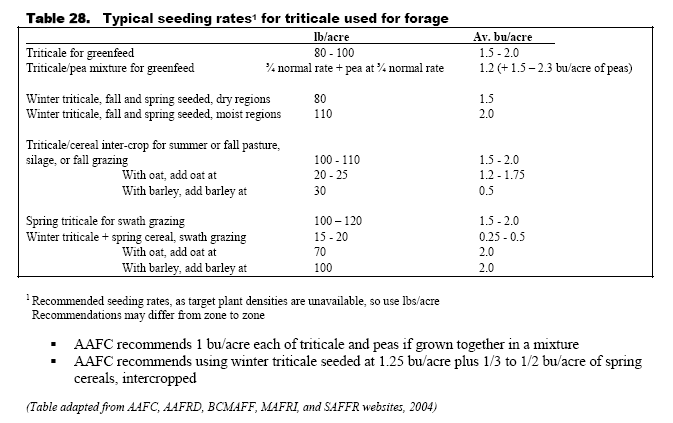
Within limits, higher seeding rates in triticale lead to:
- Higher crop yields.
- Better weed competition.
- Earlier maturity.
- Fewer tillers per plant.
- Shorter plant height.
Seeding rates should generally be adjusted upwards for:
- Large seed size.
- Low seed germination rate.
- Deep seeding (not a recommended practice).
- High moisture and yield potential conditions.
- Heavy textured soils.
- Rough seedbeds.
- Heavy weed pressure conditions (especially in organic production).
Lower seeding rates may be suitable for dry conditions. Triticale does not tiller as freely as wheat, and has greater difficulty in compensating for low stand establishment. Use your own experience to adjust plant density targets to your local conditions.
Lodging
Triticale can lodge because of:
- Height.
- Lush growth under conditions of high moisture and fertility.
- High seeding rates.
Earlier seeding appears to reduce this tendency towards lodging.
Seeding date
For seeding spring triticale, plant as early as possible to reduce risk when harvesting grain and to maximize forage yields. Because spring triticale is a late maturing crop, seeding for grain production should be completed by the second week of May in all parts of the western prairies and British Columbia. If conditions allow, seed as early as May 15 for maximum yield.
Optimum seeding dates for winter triticale for grain are the same as those for winter wheat. At least three or four weeks of growth are needed to develop seedling hardiness in winter triticale. This allows winter triticale to develop at least 3 to 4 leaves and adequate crown establishment.
The range of suitable dates for seeding winter triticale is from the second week of August (the earliest date recommended for more northerly and higher altitude sites) to no later than the second week of September (for southern prairie locations).
Variation in soil temperature for germination is the main environmental factor influencing the optimum planting dates for winter triticale. Late seeding usually results in lower winter hardiness, since winter triticale does not harden as fast as winter wheat and fall rye. Seeding too early allows too much seedling growth and increases the risk of winterkill.
Winterkill can be minimized using the same optimal management procedures as for winter wheat (for more detail refer to Winter Wheat in the Parkland Area of Alberta, Agdex 112/11-1). This involves direct seeding into tall standing stubble to trap snow, and to prevent the seedling crown structures from being exposed to critical low killing temperatures. Avoid late, deep seeding as it results in poor establishment of the winter triticale crop.
Consult the section of this manual on triticale forage use for optimum seeding dates for special forage applications. Seeding dates for special purposes, including forage use or swath grazing, should be adjusted according to general guidelines shown in Figure 17 and Figure 18, and adjusted for local conditions and management objectives.
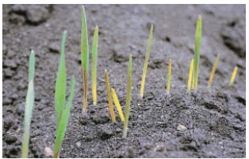
Photo - Cold temperature damage in triticale
Seeding depth
Shallow seeding is recommended for winter triticale to ensure rapid emergence and optimal winter hardening. Triticale should be seeded between 0.5 to 1.5 inches deep (optimum 1 inch) and never deeper than 2 inches.
Shallow seeding allows for:
- More rapid emergence.
- Early vigor.
- Improved competition with weeds.
Due to its large seed size, triticale is able to emerge from deep seeding. However, this usually results in decreased emergence and less plant vigour. Just as with winter wheat, shallow planting of winter triticale is recommended to ensure a rapid emergence and a hardening of the crown to improve winter survival.
Seed quality and seed standards
Use pedigreed seed as it has many superior properties as compared to bin-run seed:
- Guaranteed genetic purity.
- Certified low levels of other crop types and weeds.
- Potentially lower levels of seed-source disease and pest infection.
- Tested for germination.
- Better seed size uniformity.
- More even germination.
- Generally better yield potential.
If using bin-run seed, ensure that seed is cleaned to pedigreed seed standards, and that germination percentage is never less than 75 percent. Use accredited seed laboratories to check seed quality. Samples with germination percentage as low as 75 percent may also be reduced in vigor.
Fertilizer Requirements of Triticale
In general:
- Recommended fertilizer rates for forage use are generally similar to those for producing grain.
- Base your fertilizer requirements on results from soil tests, and fertilize according to pre-planned yield targets for the particular field.
- Adjust yield targets and fertilizer applications according to previous crop, soil type, and expected seasonal moisture levels.
- On fields that have received high levels of manure application (to which triticale is well adapted especially for silage production), monitor soil nutrient levels for over-accumulation of P and K in the soil.
- Banding with N is recommended.
- Placing some of the N with the seed can be an effective procedure under optimal conditions. However, maximum recommended rates must be reduced under drought conditions.
- Ammonium nitrate (34-0-0) with the seed is safer than 46-0-0 (Table 32).
- Double shoot, side banding, mid-row banding air drills and/or air seeders with spreader boots all reduce the risk of seed or seedling burn from fertilizer placement with the seed. Air seeders with spreader boots increase the Seed Bed Utilization (SBU). For example 9” sweeps with 3” spreader boot is 33% SBU (Table 32).
- Double shoot systems, new mid-row air drills, or side banding units have seed and fertilizer separation to reduce risk of seed or seedling burn.
Production goals can be set by reviewing the specific suggestions that are included with the soil test results. General guidelines for fertilizer application on the prairie provinces can be used when soil test results are unavailable (Tables 29 to 32).
When growing winter triticale, N-P-K-S should normally be banded at recommended rates.
If you are broadcasting additional nitrogen in spring, 34-0-0 is preferred as losses can occur with 46-0-0 when there is low moisture and temperatures higher than 10 degrees Celsius.
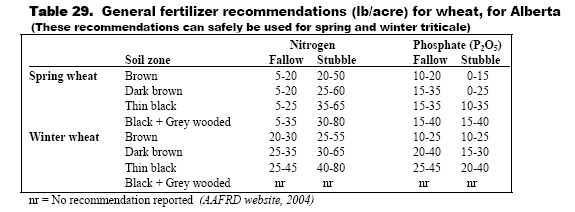


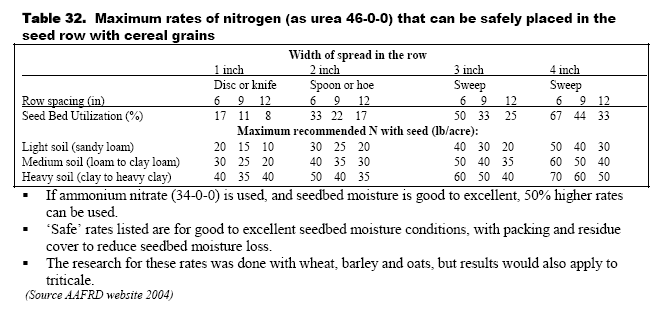
Grain Harvest and Storage
Harvesting and storage management for triticale is generally similar to that for wheat. However, spring triticale for grain is a late-maturing crop, and is also more susceptible to sprouting conditions at harvest than HRS wheat.
In dryland conditions, straight cutting of triticale is recommended where conditions allow. This is because straight cutting for grain can help reduce losses from pre-harvest sprouting, which triticale is much more susceptible to than is wheat.
Combining at 14 percent grain moisture is considered dry for triticale. This moisture content will not cause storage problems.
Moisture content lower than 13.5 percent is very desirable, as most moulds and insects tend to be inactive below this moisture level. Risk is also reduced when storage temperatures are lowered below:
- 8OC for insects.
- 3OC for moulds.
- –8OC for mites.
Kernels with moisture content up to 20 percent can be harvested and, if properly dried, will not lose quality. If drying triticale grain, maximum desirable temperatures are:
- 40OC for seed.
- 65OC for commercial grain.
If swathing the crop, ensure that the grain moisture is 35 percent or lower. It is recommended that winter triticale be straight combined, as it matures three weeks earlier than spring triticale and several classes of wheat. Combine settings should be set similar to those for wheat, with care taken to slow the cylinder speed to minimize grain cracking and splitting.
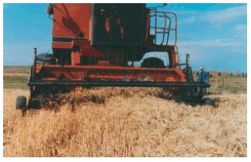
Photo - Combining spring triticale (Pronghorn breeder seed)
Triticale Grain Grade Standards
Kernel size and test (bushel) weight
- Triticale test weight is comparable to other cereals, except some wheat classes and hulless barley.
- Registered varieties have test weights that readily allow them to meet the minimum requirement of the top grade of No. 1 Canada Triticale (65 kg/hl = 52 lb/bu; Source CGC Official Grain Grading Guide, August 1, 2003) (Table 34).
- Triticale has a very large kernel size which should always be taken into account when determining seeding rates, and for which processing adjustments may also be needed for grain use in value-added technologies.
Modern triticale varieties have very high kernel weights, and test (bushel) weights that are comparable or superior to many other cereal grains. The range of differences between varieties for test weight is of similar order for all the cereal crops listed in Table 33 except for milling wheat and malting barley, where uniformity of test weight in different varieties is a more stringent registration requirement.

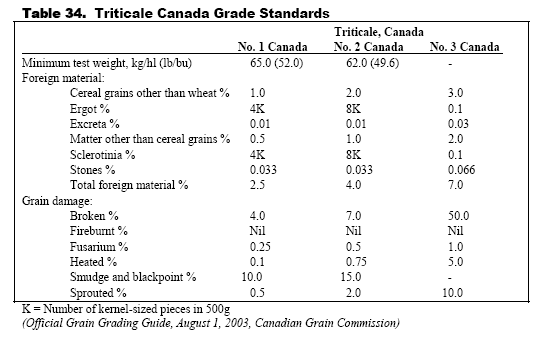
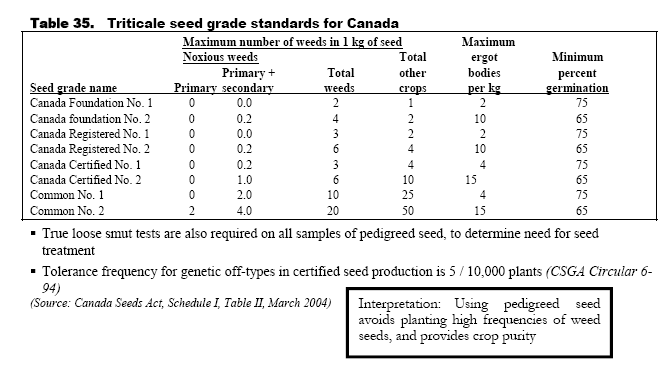
A wide range of seed size is found between varieties in all cereals, including triticale (Table 33). It is particularly important to properly adjust seeding rates for triticale to meet adequate target plant densities in the field due to:
- Wide range of differences in varieties
- Variability between seed lots
- Large average kernel seed size
Adjustments are often needed to milling and processing equipment for optimal performance when working with larger seeded grains.
Plant Breeder’s Rights
Avoid becoming involved in unauthorized sales of varieties that have Plant Breeders Rights (PBR). Fines are substantial for illegal use. Many varieties of grain are managed under Plant Breeder’s Rights legislation. This legislation allows the owner of the variety to prevent the unauthorized sale or use of a protected variety’s seed. Fines for unauthorized use are substantial, and active programs are underway to identify all PBR-related unauthorized seed use in Western Canada. Contact your seed distributor for clarification of your rights and obligations when growing a PBR variety.
|
|